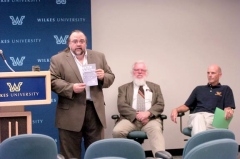Tackling Marcellus Shale factor
thetimes-tribune.com/opinion/editorials-columns/guest-columnists/tackling-marcellus-shale-factor-1.1222023#axzz1bnmom3Ug
Tackling Marcellus Shale factor
BY BRIAN ORAM (GUEST COLUMNIST)
Published: October 23, 2011
 In 1795 settlers in Montrose discussed water that would “bubble and catch fire like black powder.” Later it was determined that Salt Spring contained methane gas. What is now Salt Spring State Park in Susquehanna County was once the site of an attempted oil and salt operation.
In 1795 settlers in Montrose discussed water that would “bubble and catch fire like black powder.” Later it was determined that Salt Spring contained methane gas. What is now Salt Spring State Park in Susquehanna County was once the site of an attempted oil and salt operation.
Today it appears the development of the Marcellus Shale is commercially viable. Methane is not uniformly distributed in the Marcellus Shale, but it is virtually everywhere in our environment. Methane can be found in saturated soils, lake sediments, wetlands, landfills, and the Catskill Formation (our source of drinking water) to name a few. There is no drinking water standard for methane gas, but there are guidance levels due to concerns for the potential of accumulation which can create an explosive environment. The guidance level in Pennsylvania is 7 milligrams per liter of methane in water. There also are action levels when airborne concentrations reach 10 percent of the lower explosive limit. The level of methane in water and the level in a confined headspace do not correlate. If gas is collecting in the headspace of a well the problem is that the well is not properly vented and this needs to be corrected. It does not indicate methane is present in the water below.
Prior to Marcellus development it had been my experience that levels of methane can range from not detectable to greater than 28 miligrams per liter. I lit my first tap in 1989.
The concentration of methane gas in water is highly variable. Methane levels can change greatly in the same well in a matter of days and concentrations may vary widely. This was one reason, in 2009, I proposed lowering the recommended action level in Pennsylvania to its current state. The level of methane fluctuation is determined by many factors including barometric pressure, rainfall amounts, ice cover on soil, groundwater levels, water well operation, depth of pump setting, depth of well, and geological setting. All of these factors can cause the headspace and dissolved methane to fluctuate. Given this all residents should vent their wells.
Currently baseline water testing is being done throughout our area. These tests demonstrate that our groundwater is not pure. Local groundwater contains measurable to explosive levels of methane gas and other trace elements. Of specific concern is that up to 50 percent of private wells may not meet a primary drinking water standard because of bacterial contamination, arsenic, barium or lead. I call this the “Marcellus Shale factor.” The development of this natural resource has piqued our attention and is another reason we need to work together to test our water and understand the challenges we face. The only way we can address our groundwater challenges is to understand these issues and take corrective action.
Throughout my career, I have conducted extensive groundwater and private well testing. We created the Water-Research.net Web portal as a free information resource and we are continuing our work on the Citizens Groundwater and Surfacewater Database for our area. In addition, we are conducting a private well owner watershed survey and are planning to offer free radon in water screening. This data warehouse will enable us to better understand our resources, current issues, and track future change. It can also be used to make decisions that ensure the health, safety and welfare of our community and environment.
Recently, the Department of Environmental Protection determined methane levels in Dimock meet the requirements of the consent document agreed to by all parties. It is my hope that continued monitoring will confirm this conclusion and that we all work together to move forward with greater understanding. We are a community and may not all agree but we must work together – this is our home.
It is critical that local stakeholders form task forces and create community resources to educate, assist and inform ourselves to make educated decisions based on science, not fear. Our first order of business should be the development of private well standards and a program to upgrade existing private wells. This should be in addition to the development of best-management practices for development of the Marcellus Shale in our region. These actions are critical to ensure the health, safety and economic welfare of our citizens and environment.
Brian Oram is a licensed professional geologist and the founder of
B.F. Environmental Consultants. Previously he worked at Wilkes
University’s Center for Environmental Quality.
